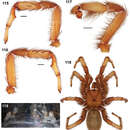Description
provided by Zookeys
Specimen preparation and condition. Specimen collected live from burrow, preserved in 70% ethanol. Coloration moderately faded. Pedipalp, leg I left side removed, stored in vial with specimen. General coloration. Carapace, chelicerae, legs dark yellowish brown 10YR 4/6. Abdomen uniform dark reddish gray 5YR 5/2 dorsally. Very light diminutive abdominal color pattern comprising 3 patches along dorsal midline (Fig. 118). Cephalothorax. Carapace 6.32 long, 5.44 wide, clothed in light white hairs, stout black bristles along fringe; surface smooth, pars cephalica elevated slightly. Fringe, posterior margin lacks black bristles. Foveal groove deep, straight. Eyes on low mound. AER slightly procurved, PER slightly recurved. PME, AME subequal diameter. Sternum moderately setose, STRl 3.45, STRw 3.00. Posterior sternal sigilla moderate sized, positioned centrally, not contiguous, anterior sigilla pairs small, oval, marginal. Chelicerae with distinct anterior tooth row comprising 6 teeth, posterior margin with single row of small denticles. Palpal endites with patch of small cuspules on proximal, inner margin, labium lacks cuspules, LBw 1.02, LBl 0.42. Rastellum consists of 5 very stout spines not on a mound. Abdomen. Setose, sparse heavy black setae intermingled with fine lighter colored setae. Legs. Leg I: 6.10, 4.19, 4.13, 2.68, 2.40; leg IV: 6.10, 3.30. Light scopulae on legs I, II tarsus, metatarsus. Tarsus I with single, slightly staggered row of 14 trichobothria. Leg I spination pattern illustrated in Figures 115, 116; TSp 3, TSr 5, TSrd 5. Metatarsus I anteverted retrolaterally, modified with mid-ventral mating apophysis terminating in triangular mound. Pedipalp. Articles slender (Fig. 117). PTw 1.40, PTl 2.50, Bl 1.36. Embolus slender, tapering sharply toward tip, slightly curved, lacking serrations (Fig. 117).
Variation.Known only from the type specimen.
- bibliographic citation
- Bond J (2012) Phylogenetic treatment and taxonomic revision of the trapdoor spider genus Aptostichus Simon (Araneae, Mygalomorphae, Euctenizidae) ZooKeys 252: 1–209
- author
- Jason E. Bond
Distribution
provided by Zookeys
Aptostichus dantrippi as currently defined is distributed primarily throughout Kern County with a few specimens taken from the Temblor Range along the western border with San Luis Obispo County (Map 12). The distribution essentially “rings” the ranges that bound the southernmost extent of the Central Valley and includes the San Emigdio, Tehachapi, and Greenhorn Mountains. The species is mostly restricted to the south valley alluvium and basins, Sierran steppe and mixed and coniferous forests ecoregions of Kern County (Map 12). The only known male specimen was collected during late fall (October). The DM prediction corresponds closely to the known distribution but predicts a high probability of occurrence along the Transverse Ranges. Conversely, the Bakersfield locality along the banks of the Kern River is located in an area of relatively low probability of occurrence; it is likely that this population is relictual given the nature and paucity of the habitat at this location.
- bibliographic citation
- Bond J (2012) Phylogenetic treatment and taxonomic revision of the trapdoor spider genus Aptostichus Simon (Araneae, Mygalomorphae, Euctenizidae) ZooKeys 252: 1–209
- author
- Jason E. Bond

